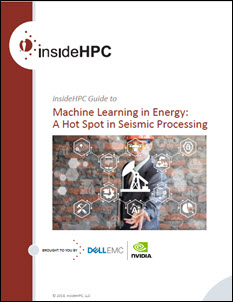The is the first entry in a five-part insideHPC series that takes an in-depth look at how machine learning, deep learning and AI are being used in the energy industry. Read on to find out how machine learning is driving energy exploration.

Download the full report.
Opportunities Abound
The Internet of Things (IoT) is changing the way industrial machinery and related processes work together and report back with information such as position, temperature, pressure, humidity and so on. The worldwide market for the number of these types of sensors that will be deployed is estimated to be in the billions. With so much information being generated many times per second, in some instances, filtering and analytics must be performed where the sensors are located (or close by), rather than in faraway data centers.
Additionally, deep learning aids in the inspection and preventive maintenance in a wide range of complex structures, from understanding the massive amount of data generated by IoT sensors, to determining where pipelines may fail first. The use of a combination of technologies aids in understanding the physical systems, as well as in predicting where components may exhibit problems in the future.
Energy Exploration
Finding new deposits of energy requires a significant investment in a wide range of capital equipment, from exploration platforms to the computer systems that analyze the raw data and give engineers information on where to drill with confidence. A new tool in the IT arsenal, AI systems, assist engineers in making sense of the tremendous amounts of data acquired in the field.
Gazprom is looking at AI for a variety of applications, ranging from drilling and well completion to modeling oil-refining strategies.
High-performance computing (HPC) systems have been used for many years to understand much of the seismic data acquired from sensitive sonar equipment. Obtaining more accurate information from within the ground leads to a more focused drilling plan, which reduces costs as well as minimizes the effect on the environment. While HPC systems could always be expanded to include more and faster CPUs, this could become prohibitively expensive over time. New techniques using innovative hardware systems, such as simultaneously using thousands of GPUs from NVIDIA, along with state-of-the-art software, allows companies to confidently find new reserves, as well as maximize the efficiency of the oil field. A reduction in cost at the start of the workflow process can lead to significant savings downstream. According to the U.S. Department of Transportation, a seismic survey costs about $30,000 per square mile, while the cost for an offshore oil well can approach $1 billion.
HPC for Energy Exploration
From the initial surveying to transporting oil to where it is demanded can take years of planning, exploration and, finally, drilling. Yet, once the drilling has commenced, additional resources are needed to observe and analyze current leakage and that which may occur in the future. A new well may cost hundreds of millions of dollars. So, it is critical that accurate decisions be made early in the process to avoid costly planning changes down the line. Enter the world of HPC and, increasingly, ML.

From the initial surveying to transporting oil to where it is demanded can take years of planning, exploration and, finally, drilling.
The data produced by a seismic survey can be significant. Terabytes to petabytes of data may be produced in the field, which must then be brought into a seismic processing system to determine where reserves may lie and the most optimum methods to extract the oil (or natural gas). Significant resources are needed, in terms of servers, storage and networking in order to make sense of the raw data.
Three-dimensional models of the Earth’s subsurface are created in order to find energy deposits. Sound waves are sent downward, and the reflection patterns give scientists a view of what is below the surface. Many individual sound waves are sent, and then an enormous amount of data is captured and must be analyzed. HPC systems are required to remove noise from the data and to create the 3D model. The more receivers that are present, the more of an exact understanding of the Earth below is achieved. This whole process uses significant numbers of servers and storage and can take months to complete. Any tool that reduces the time needed to understand where the deposits are located can save a company millions of dollars.
Over the next few weeks, this insideHPC Guide series will also cover the following topics:
- Energy Companies Embrace Deep Learning for Inspections, Exploration & More
- Edge Computing Proves Critical for Drilling Rigs, Pipeline Integrity
- Computing Environments Options for Energy Exploration and Monitoring
- Determining Where & How to Adopt Machine Learning Technology
Download the full report, “Machine Learning in Energy: A Hot Spot in Seismic Processing,” courtesy of Dell EMC and Nvidia, to learn more about how machine learning is being used to move the energy industry forward.



